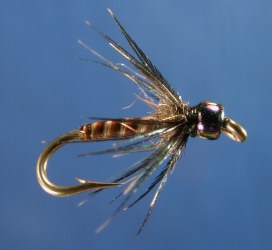Invicta Flies - Pixie Dust
This small spider-style fly may be indicative of a hatching midge or small mayfly. The body is quite realistic, and the hackle gives it some "pumping" action, while the glass bead gives it a bit of flash attraction. Good fly to use as a dropper during midge hatches or in searching. The luster of the mole dubbing guard hairs, the sheen of the starling hackle, and the flash of the bead head, make it sparkle like magic dust in sunlit streams.

Hook: Mustad 3906B, #18
Thread: Danville Prewaxed 6/0 black
Abdomen: brown goose biot
Thorax: mole dubbing with guard hairs
Hackle: soft, webby body feather from starling or similar
Head: Killer Caddis Glass Bead, gunmetal
Tying Instructions:
1) Onto the hook place a "Midge" size Killer Caddis Bead. Place the hook in the vise and securethe tying thread. Use thread wraps to build a small "dam" behind bead to hold it in place. Wind the thread back to the bend of the hook.
2) Tie in the goose biot at the bend on the near side of the hook by the tip. The butt of the goose biot should be curving toward you. (This will give us the smooth, segmented body.)
3) Wind the thread forward to the half-way point of the shank. Carefully pull the goose biot straight up and over the shank. Continue winding forward to the tying thread, making sure the subtle segmentation formed by the contrasting colors shows clearly. Tie off and clip the excess.
4) Dub a thorax of mole dubbing about as wide as the bead.
5) Tie in the starling hackle by its tip. Fibers should be long enough to extend to the bend. Take one full turn and tie off. You should now be directly behind the bead head. Clip excess.
6) Whip finish and carefully cement the thread wraps. For durability, you can run a drop of cement along the biot body as well.